Backpacking Adventures in the Wind River Range
Thinking about a camping trip to the Wind River Range? Are these must-haves for your backpacking adventure:
- Hiking
- Fishing
- Wildlife sightings
- No throngs of tourist traffic, or RV generators running into the wee hours of the morning!
Well, then the peaceful and scenic Wind River Range in Wyoming might be just the spot! Are you planning to drive there? If so, check out our road trip checklist with tips on what to pack for the best adventure travel!
The Wind River Range
The Wind River Range is a 100-mile long chain of towering granite peaks, pristine alpine lakes, and glacier-carved meadows. It remains a special place for those seeking adventure off the beaten path.
Whether you are fishing, camping, or rock climbing, we’ve included everything to help you prep for your summer backpacking adventure in the Winds, as they’re commonly called.
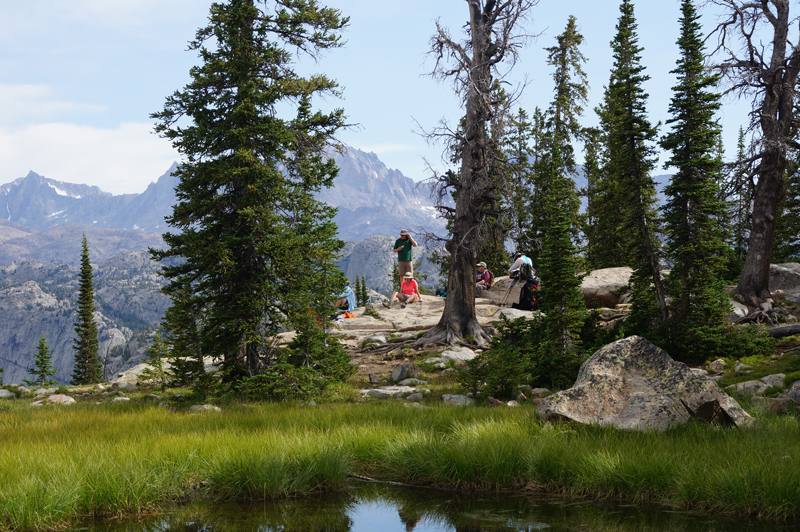
Photographer’s Point, Wind River Range
Highlights Of The Wind River Range
- Cirque of the Towers– a stunning semi-circle of 12,000-foot peaks
- Gannett Peak– the tallest mountain in Wyoming at 13,804 feet
- Titcomb Basin– a picturesque valley surrounded by lakes and mountains
- Skyline Scenic Drive- If you are not up for carrying a backpack and hiking some good miles into the wilderness, you can still get a taste of what the Wind River Range has to offer. The Skyline Scenic Drive takes you 17 miles outside of Pinedale, ending at the Elkhart Park Trailhead.
- Alpine Rock Climbing– The Wind River Range has incredible trad climbing. You’ll find both single-pitch and multi-pitch climbing with a wide range of grades from 5.6 to 5.13c in an alpine environment.
Wildlife in the Winds
Wildlife sightings may include bighorn sheep, owls, bears, deer, elk, and eagles. In addition, the headwaters of the Green River, along with hundreds of lakes and streams, are teeming with rainbow and cutthroat trout!
Both black bears and grizzly bears can be found in the Wind River Range, and although sightings are rare, be prepared. Keep your campsite clean and store food properly (see our tips below).
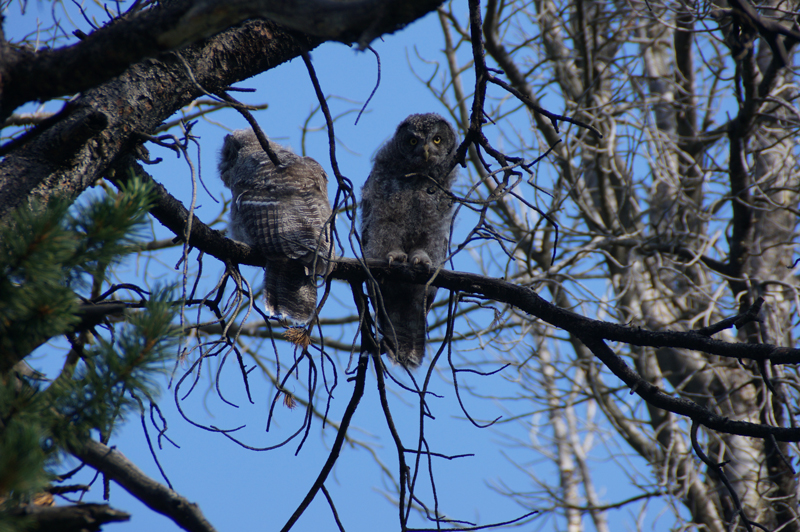
Owls watching over our campsite in the Winds.
Getting There: Access to the Wind River range
If you are flying into the area, the closest major airports to the Wind River Range are found in Jackson, Wyoming, or Salt Lake City, Utah. From Jackson, the drive is about 3 hours. From Salt Lake City, the drive to the Winds is closer to 5.
Access to the Wind River Range from the South or West
If you’re coming from places like Utah’s National Parks, Idaho, Grand Teton National Park, or Yellowstone, you will most likely visit the West side of Wind River Range. To hike in, you’ll use either the Big Sandy trailhead or the Elkhart Park trailhead.
The Big Sandy Trail is the southernmost trail that leads into the Wind River Range and provides access to the Cirque of the Towers, Deep Lake, Black Joe Lake, and Big Sandy Lake. Located 54 miles south of Pinedale, you will need to drive on a mix of paved and dirt roads to reach the trailhead.
Driving to the Big Sandy Trailhead is not quite suitable for large RVs. In addition, flash floods and summer thunderstorms can cause road closures, so always check the weather before departing.
However, the Elkhart Park Trailhead is at the end of Skyline Scenic Drive, a paved 17-mile road that starts near Pinedale. This trail provides access to Gannett Peak and the Titcomb Basin. And is much easier to manage with a large campervan van or RV.
Pinedale is the closest ‘big’ town and the best place to stock up if you’re coming from points North and West. The town is small but filled with shops, restaurants, and plenty of accommodations.
Farson is another place to stop for gas, food, or last-minute items. However, Farson is not a town, just a crossroads. And the last time you really get cell service!
Access to the Wind River Range from the East
If you’re coming from Colorado or points East, you’ll head towards Lander, Wyoming. Similar to Pinedale, there are plenty of shops, restaurants, and places to stay. However, Lander is more your quintessential mountain town. And Lander was voted one of the best outdoor towns in America!
In Lander, there’s easy access to Sinks Canyon State Park, Popo Agie Falls Trail, Pete’s Lake Trail, and several campgrounds. Other towns nearby include Hudson, where they’re hosting this year’s overlanding and van life gathering, the Wind River Rally!

Fly fishing for dinner on the Green River.
Camping and Living the Van Life in the Wind River Range
There are a few campgrounds on both the East and West sides of the Wind River Range. However, most campers prefer to backpack into the Winds and select a spot. Here there are no designated campsites, no permits needed, and no services. It’s all wilderness!
However, if backpacking is not your thing, it is possible to camp in a more traditional campground and do day hikes into different areas. Below we’ve featured our favorite campground, Big Sandy.
Big Sandy Campground
Big Sandy Campground is one of the most popular campgrounds for accessing the Wind River Range. There are no reservations or permits needed. Therefore, all campsites are on a first-come, first-served basis. However, access to this area is very limited due to snow and road conditions.
To get to Big Sandy Campground, you will drive about 40 miles on mostly dirt and washboard terrain. That being said, the drive to Big Sandy Campground is not quite suitable for large campervans and RVs.
You will find 10 sites total in Big Sandy Campground, a few of which have access to stock pens if you’re traveling with horses. There’s also a large dirt lot for backpackers, as the Big Sandy Trailhead starts at the parking lot.
If you had a campervan or small RV, you could certainly park in the lot and stay overnight. There is also a compost toilet in the parking lot. And pens for stock animals.
As Big Sandy is a primitive campground, you will not find the following:
- Running water. Be prepared to filter your water from the lakes and streams
- Cell service
- Trash cans or dumpsters. You must pack out all of your trash!
- Bear boxes. Use proper food storage techniques. More on this below.
Big Sandy Campground is typically open between the end of June through September.
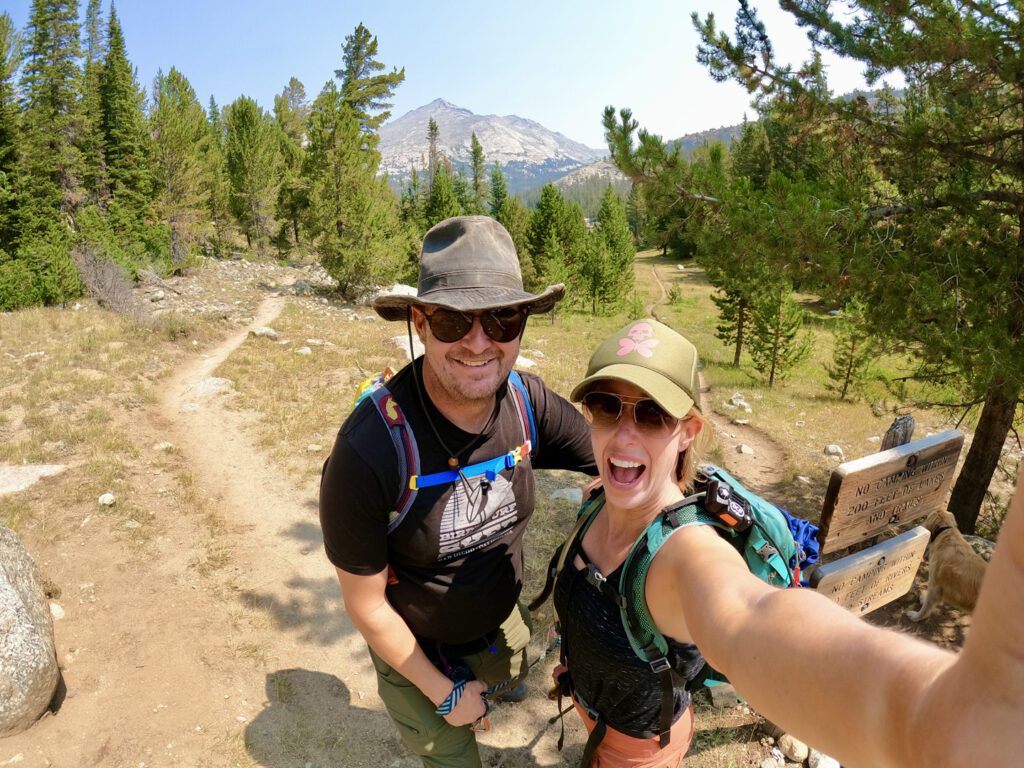
You can do day hikes into the Winds, carry a larger pack and camp a few nights, or work with a guide service that can haul in your gear!
Should You Hire a Guide to Backpack or Hike the Winds in Wyoming
If you want to try backpacking in the Wind River Range but are not sure how to get started, think about hiring a guide. Or book your trip through an outfitter. This will ensure you are well-prepared for your backcountry adventure.
In addition, they can take care of most of the heavy lifting and even load your packs on horseback for the hike! This means you can do your hike into the Winds with a light daypack! And when your hike is over 8-10 miles, you will most certainly appreciate it!
Many guiding services provide everything from tents and meals, to round-trip transportation from Jackson, Wyoming. Highly recommended outfitters include:
Big Sandy Lodge: Outfitter and Cabins
Big Sandy Lodge is our favorite outfitter. They have 10 cabins, a lodge for meals, shared bathrooms and showers, and wranglers that can haul your gear in on horseback.
Big Sandy Lodge is family-owned and operated, and they really go the extra mile to make you feel welcome. And even if you are not booking a cabin, you can still join other guests in the warm, cozy lodge for breakfast or dinner.
Lastly, the Big Sandy Lodge is about a mile from the Big Sandy Campground and Trailhead.
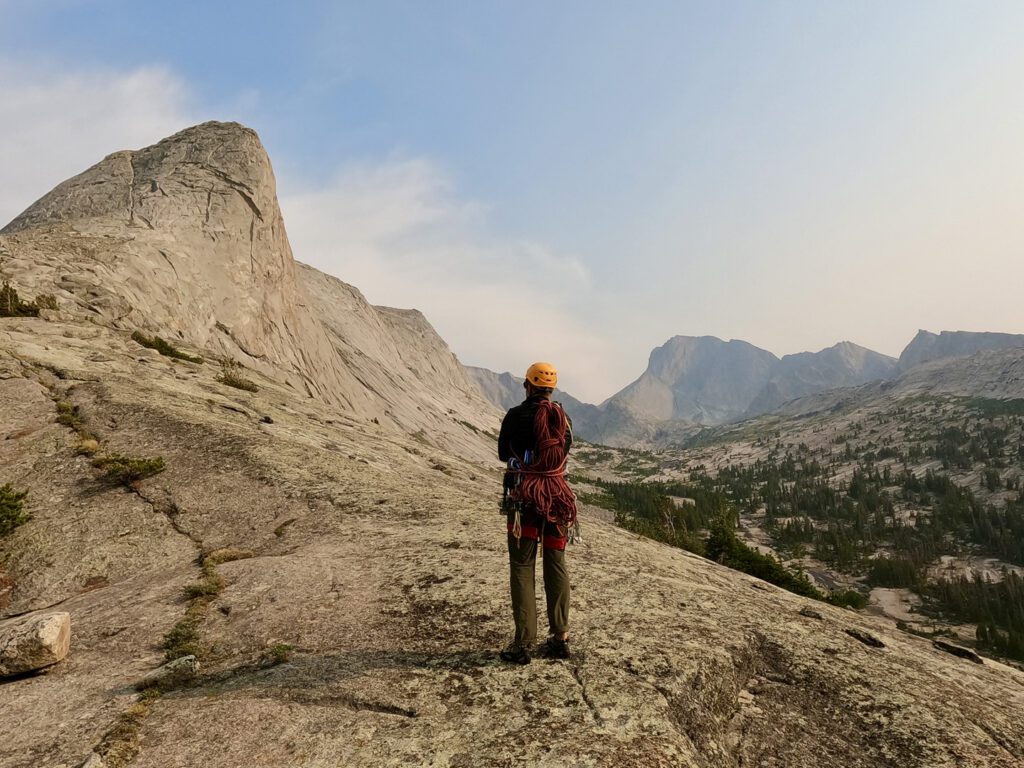
Planning to rock climb in the Wind River Range? Make sure you have a full trad rack and everything ready for big wall alpine climbing!
More Tips For Your Wind River Adventure
Map Reading:
Know how to use a compass and read a topographic map, especially if you will not be hiring a guide. Trails are not well-marked and most see very light traffic throughout the summer. We also picked up the Falcon Guide: Hiking Wyoming’s Wind River Range!
Are you a climber? Well, then you might want to check out the Falcon Guide: Climbing and Hiking in the Wind River Range.
Wind River Camping Locations and Fees:
There are no entrance fees at the Winds, however, there are campground fees at the designated campgrounds. You can also hike a few miles into the Winds and set up camp without paying any fees. Then you can take on a bigger effort like hiking all the way to Deep Lake, Black Joe Lake, or the Cirque of the Towers.
Remember, camps should be set up 200 feet from lakes or streams, and 100 feet from the road or trail.
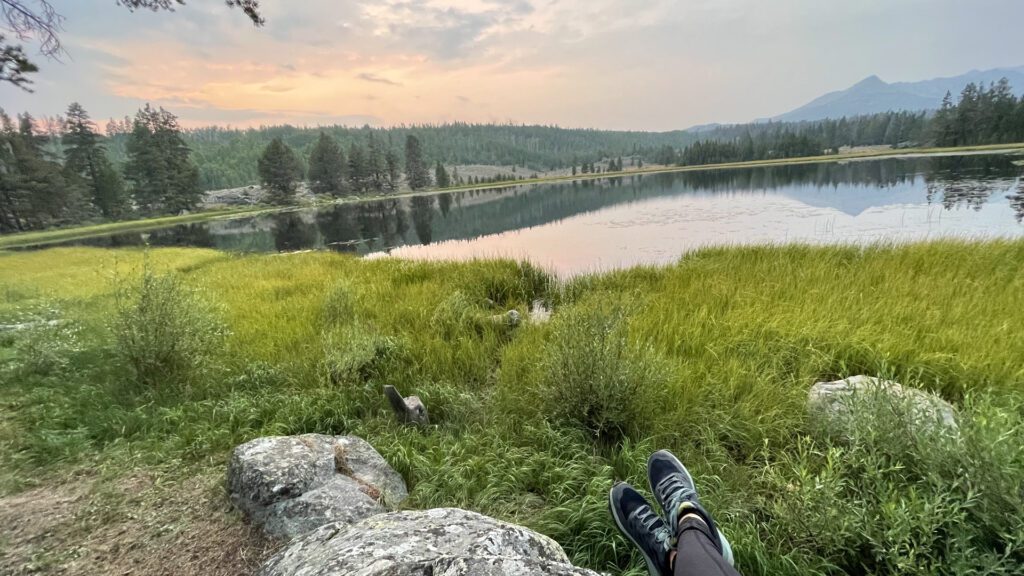
The view from Big Sandy Lodge, just adjacent to the Big Sandy Trail where you can begin your hike in!
Wyoming Wind River Weather:
The best time to visit the Wind Rivers is July through mid-September. This way all trails should be clear of snow. And, the later you go, you can avoid the dreaded mosquitos.
However, keep in mind chilly nights and thunderstorms are common above 9,000 feet in the summer. And snowfall can also occur year-round. Always be prepared. We had 4 days of rain and temperatures in the low 40s in the middle of August! Even though the weather report called for 60s and sunny!
Therefore, bring good, waterproof rain gear that you can hike in for cold and rainy weather. And check the latest conditions before your departure.
Hiking preparedness:
For the best experience in the Winds, make sure you are comfortable carrying a mid-sized pack and hiking several miles a day. And, hiking at elevations over 10,000ft.
Does a 40-pound pack seem like too much? Then reach out to an outfitter or guide service like the Big Sandy Lodge to reserve horses and wranglers to carry your gear in!
As an example, our hike along the Big Sandy Trail to Black Joe Lake was 8.5 miles, and 2,000ft. of climbing. And, the majority of the elevation gain was in the last 3 miles. We got an early start and are in good shape, but it still took us over 4 hours to hike 8.5 miles!
Don’t forget to break in your hiking shoes well before your trip. Remember, this is a remote area. And, access to shops that sell camping equipment, as well as medical services, are quite far away.
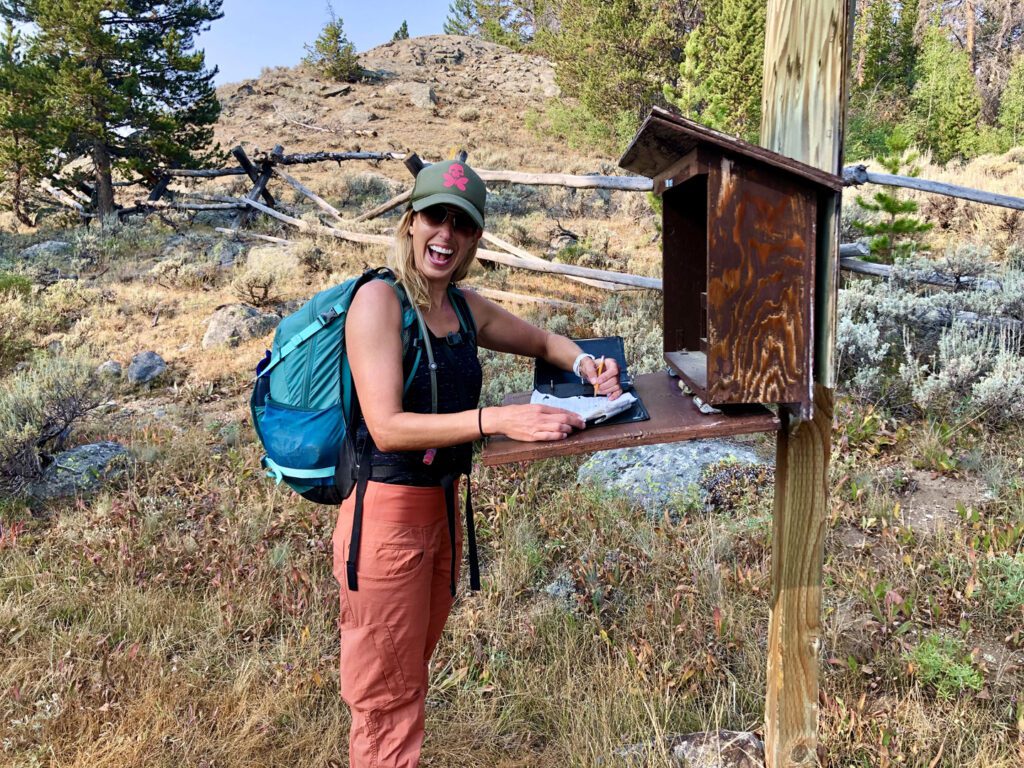
Before you start down the trailhead, make sure you’ve done a few hikes in your shoes and carried a pack of the same weight you’ll be bringing in. Not comfortable carrying a big pack? Hire a guide to bring your gear in!
Packing for Backcountry Travel:
Learn how to pack a backpack! In addition, determine what essentials you’ll need based on your type of trip. Don’t skimp on the rain gear or the food! We’ve also pulled together a list of what travel essentials to pack for your best outdoor adventure.
Water:
There is easy access to water from lakes and streams, however, you will need to purify the water by boiling, filtering, or using chemical tablets. Outdoor Gear Lab reviewed some of the best water filters on the market and almost all are available on Amazon.
We use Life Straw and had no issues, but we did have to set up quite a large system to accommodate 5 people and 3 dogs! And, walking back and forth to the lake to fill your water bladder and/or buckets is definitely a daily chore.
Altitude:
The Wind River Range is above 9,000 feet. Therefore, make sure to spend a day or two acclimating to higher altitudes at the trailhead campgrounds. Again, this is why we love the Big Sandy Lodge. A day or two at the cabins and you’ll be ready!
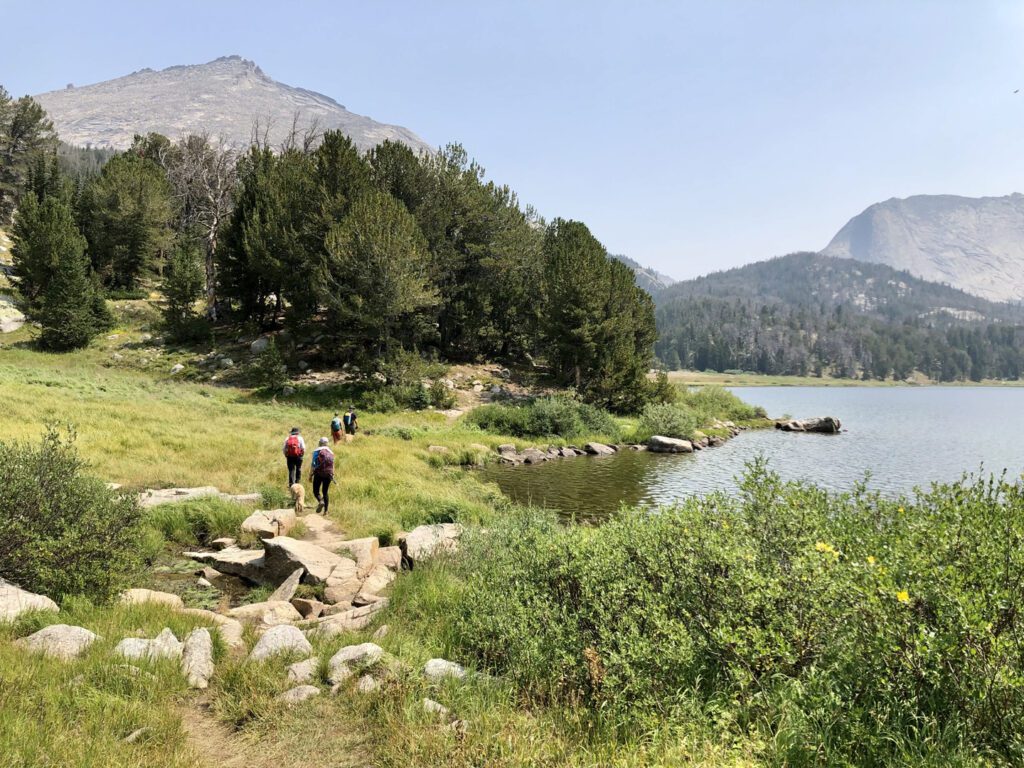
The quiet mountain surroundings in the Winds are filled with wildlife. If you’re lucky you may see deer, elk, marmots, eagles, moose, and bears!
Bear Safety and Food Storage:
Learn how to tie up your food or bring secure food canisters to keep the critters out! There are no bearproof food storage boxes located in the Winds.
So, purchasing a few bearproof canisters, dry bags, and smell-proof bags that you can travel with is a great idea. In addition, we pack bear spray, even traveling with a 70-pound hound dog. Keep it on you and know how to use it.
Dry bags like Osprey’s 20L Ultralight Dry Sack and scent-proof bags like OPSAK and Smelly Proof are very helpful! Plan to tie up everything from toiletries to dog food.
Yes, it’s a daily chore. Well, sometimes a 3x a day chore! But, after each meal, you need to pack up your food, haul it to the tree you have your anchor set up on, and then raise it up in the air.
We recommend either buying a hanging food storage bag system or creating your own. And practice hanging your food before you hike into the Wind River Range. Here’s a good video that demonstrates the PCT bear bagging method.
Tips on keeping a bear-free campsite and staying bear-aware:
- Use a bear canister or hang your food in scent-proof bags! Put all items with a scent in the bear canister or smell-proof dry bags. This includes soaps, lotions, sunscreen, and even water bottles.
- Do not leave cooking utensils, dishes, or stoves out. It will guarantee unwanted visitors. And not just a large bear. Squirrels, chipmunks, marmots, and deer will raid your campsite for any items that look and smell like a treat!
- If cleaning fishing or cooking over a campfire, remove all clothes that smell and wear something scent-free to sleep in.
- Carry bear spray at all times. Especially when hiking in more remote locations of the Wind River Range. And, read the NPS Guidelines on how to use bear spray effectively.
- Keep a safe distance from bears if you spot one. Especially if it’s a mother and her cubs. 300 feet is what’s recommended. Resist the urge to approach for a better photo.
Need more tips on food storage and bear safety? Here are the U.S. Forest Service food storage basics.
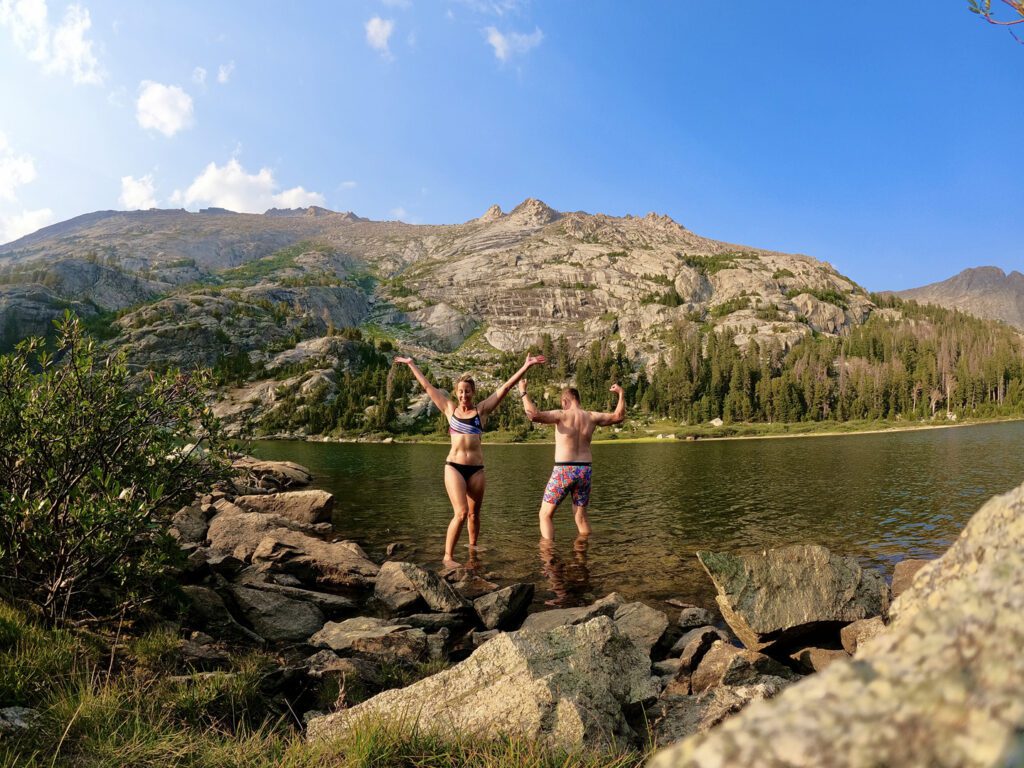
Interested in swimming while in the Winds? Be prepared for very cold temps! Our swim in Black Joe Lake lasted about 5 minutes!
Bathrooms:
Not often a topic you want to discuss, but you need a bathroom plan as there are no compost toilets or any facilities once you leave the campground or cabins. The best practice is to Leave No Trace and pack out all human and dog waste during your time in the Winds.
How to do this? We set up a private area outside of camp that served as our camp ‘bathroom’. You can purchase a portable camp toilet that comes with everything you need to feel a bit more comfortable.
If you are having horses haul in your gear, this is a nice option. Also, pack a pop-up changing tent to make it even more comfortable. You will thank me when it’s raining.
Bugs:
Mosquitos and other bugs are plentiful in the summer months. So, make sure to pick up bug spray before you drive or fly up. You may luck out on mosquitos if you hike in towards the end of August or the beginning of September. But, you could also get snow!
Fishing and Hunting in the Winds:
A valid license from the Wyoming Game and Fish Department is required for fishing or hunting in the Wind River Range. And, flyfishing is the most common form of fishing in the area.
Many of the lakes and streams in the Winds will have a number of different species of trout. From brown, rainbow, and cutthroat, to brook and lake trout. Again, make sure you have extra flies, lines, and everything else you need before you leave civilization.

Beneath the surface, these mountain streams are filled with rainbow, cutthroat, and brown trout!
Campfires:
There are campfires permitted in certain areas of the Winds. However, check the latest fire regulations before departing. In hot, dry summers, expect to not be allowed to light a fire in the Wind River Range. So if you were planning to cook your meals on an open fire, bring the Jetboil and if horse-packing in, the camp stove.
Leave No Trace:
Be respectful of wild places and ensure that whatever your pack in you must carry out. Learn more about Leave No Trace and how you can help!
More Adventure Travel Tips
There’s definitely a lot to think about when planning a backpacking trip to the Winds! And it’s such a different type of trip than visiting Yellowstone or the Tetons. Especially if you like to be off the beaten path.
We hope this gets you excited about traveling through Wyoming this summer, and if you have more questions about how we prepared, contact us!
Looking for more travel ideas for fun destinations?
- Top 8 Summer Activities in San Diego
- Cuba Libre: Travel Tips for Outdoor Adventurers in the land of Classic Cars, Cigars, and Rock Climbing
- Road Trip through Utah’s National Parks
- California’s 395: Road Trip through Bishop, Mammoth Lakes, and Yosemite National Park
TOP 8 SUMMER ACTIVITIES IN SAN DIEGO
To learn more about what we do on the regular, follow Top Rope Media’s adventures on Instagram, Facebook, or Twitter.
Until next time, happy adventuring!
– Meredith McConvill